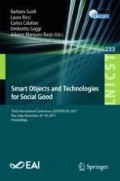Abstract
The children’s use of technology is increasing year by year and recent statistics show that children receive their first smartphone and autonomously navigate the Web when they are 10.3 years old (on average). Nevertheless, while the number of tourism packages for families with children grows, the number of websites that can be directly visited by children is small; more relevant, is the number of tourism applications developed for children. This paper discusses the design of usable and accessible websites for children, and proposes, as a case study, our experience on a dedicated section of the tourism website of a Naturalistic Oasis located close to Treviso, in Italy.
Access this chapter
Tax calculation will be finalised at checkout
Purchases are for personal use only
Notes
- 1.
Section temporarily offline from the official site http://oasicervara.it/ for technical reasons, but part of it is online at this link: http://oasikids.altervista.org/oasi-kids/.
References
I leoni del tempo. Tourism app for children (2017). https://goo.gl/HBsfSb
Ahluwalia, R.: The 50 best travel websites, Indipendent (2017). https://goo.gl/cr3XK7
Art Stories: Journey Journal (2017). http://www.artstories.it
Bernhardt, G.: Designing Usable Sites for Children and Teens (2006). https://msu.edu/user/webbsuza/atw/graceb/
Dattolo, A., Luccio, F.L.: A review of websites and mobile applications for people with autism spectrum disorders: towards shared guidelines. In: Gaggi, O., Manzoni, P., Palazzi, C., Bujari, A., Marquez-Barja, J.M. (eds.) GOODTECHS 2016. LNICST, vol. 195, pp. 264–273. Springer, Cham (2017). https://doi.org/10.1007/978-3-319-61949-1_28
Dattolo, A., Luccio, F.L.: Accessible and usable websites and mobile applications for people with autism spectrum disorders: a comparative study. EAI Endorsed Trans. Ambient Syst. 4(13) (2017)
Dattolo, A., Luccio, F.L., Pirone, E.: Web accessibility recommendations for the design of tourism websites for people with autism spectrum disorders. Int. J. Adv. Life Sci. 8(3–4), 297–308 (2016)
De Cock, R., Hautekiet, E.: Children’s news online: content analysis and usability study results (2011). https://goo.gl/FLSb8Z
De March, C.: La personalizzazione dei contenuti Web per migliorare l’attrattività delle imprese turistiche e culturali: il caso di studio di Oasi Cervara. Master’s thesis, Università Ca’ Foscari, Venezia (2016). https://goo.gl/5dAgzH
Ducan, A.: Educational websites for kids that are free, the spruce (2017). https://www.thespruce.com/best-free-educational-websites-for-kids-3129084
Erikson Institute: Technology and Young Children in the Digital Age (2016). https://goo.gl/hZSQCw
Influence Central: Kids & Tech: The Evolution of Today’s Digital Natives (2016). https://goo.gl/6K8NgW
Large, A., Beheshti, J., Rahman, T.: Design criteria for children’s web portals: the users speak out. J. Am. Soc. Inform. Sci. Technol. 53(2), 79–94 (2002)
Loranger, L., Nielsen, J.: Teenage usability: designing teen-targeted websites (2013). https://goo.gl/81zY58
Nielsen, J.: Children’s websites: usability issues in designing for young people (2010). https://goo.gl/D5q35b
Seeman, L., Cooper, M.: Techniques for the the cognitive and learning disabilities accessibility task force (COGA), W3C (2016). https://goo.gl/bdKhQi
Srnec, T., Lončarić, D., Perišić Prodan, M.: Family vacation decision making process: evidence from Croatia. In: Proceedings of the Congress on Tourism and Hospitality Industry, Opatija, Croatia - Hrvatska, pp. 432–445, 28–29 April 2016
UxKids: Comparing Usability for Kids and Adults (Part 1) (2013). http://uxkids.com/blog/comparing-usability-for-kids-and-adults-part-1/
Vučković, K., Librenjak, S., Dovedan, Z.: Internet for the youngest: computer usage and web design for the early school age children. Int. J. Emerg. Technol. Learn. 5(S12), 17–23 (2010)
WAI: Accessibility, usability, and inclusion: Related aspects of a web for all (2016). https://www.w3.org/WAI/intro/usable
White, B.: Designing For Kids Is Not Childs Play (2016). https://goo.gl/nYx9bK
Author information
Authors and Affiliations
Corresponding author
Editor information
Editors and Affiliations
Rights and permissions
Copyright information
© 2018 ICST Institute for Computer Sciences, Social Informatics and Telecommunications Engineering
About this paper
Cite this paper
Dattolo, A., De March, C., Luccio, F.L. (2018). Usable and Accessible Tourism Websites for Children: A Case Study of a Naturalistic Oasis. In: Guidi, B., Ricci, L., Calafate, C., Gaggi, O., Marquez-Barja, J. (eds) Smart Objects and Technologies for Social Good. GOODTECHS 2017. Lecture Notes of the Institute for Computer Sciences, Social Informatics and Telecommunications Engineering, vol 233. Springer, Cham. https://doi.org/10.1007/978-3-319-76111-4_20
Download citation
DOI: https://doi.org/10.1007/978-3-319-76111-4_20
Published:
Publisher Name: Springer, Cham
Print ISBN: 978-3-319-76110-7
Online ISBN: 978-3-319-76111-4
eBook Packages: Computer ScienceComputer Science (R0)

